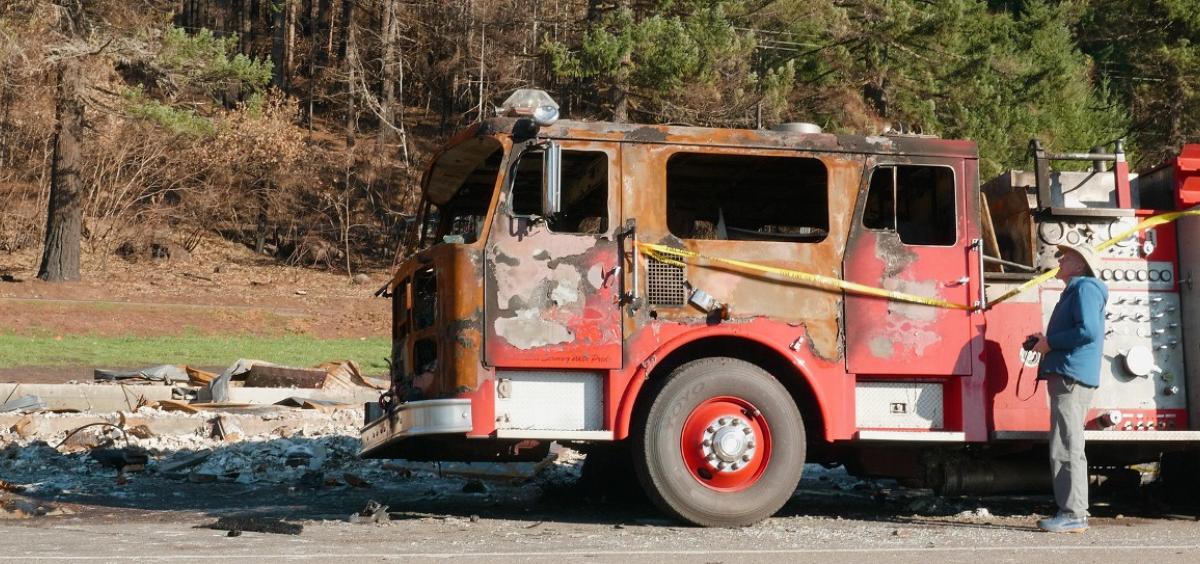
CORVALLIS, Ore. – Wildfire researchers from Oregon State University have received $750,000 for multiple projects to bridge a knowledge gap between forestry and engineering regarding how communities are affected by major fire events.
The projects aim to advance the science of wildfire risk and resilience while training a new generation of scientists better able to translate research findings into tangible outcomes for communities with a high likelihood of wildfire impact.
The strategies include embedding a doctoral student in Ashland, Oregon, the site in 2020 of the largest primarily urban blaze in Oregon history; planning a global center for transdisciplinary wildfire research on community resilience; and creating a wildfire risk and resilience graduate program jointly advised by faculty in OSU’s colleges of Engineering and Forestry.
“We’re really thinking about how these fires’ impacts on communities need to be studied,” said Chris Dunn of the College of Forestry. “The Forest Service isn’t the only entity to solve this problem, and it’s the same in academia – the College of Forestry is not the only entity. It’s not just forest ecologists and forest managers. We have to look at this across engineering, forestry, the social sciences, public policy.”
The new dual-major program will lead to a combined doctorate in civil engineering and forest engineering, resources and management.
“This immersive, transdisciplinary experience will be the only such program in the world that we know of,” said the College of Engineering’s Erica Fischer, who will lead the global center effort and co-advise the doctoral program with Dunn.
The Forest Service has provided a $500,000 grant to fund the program of the embedded student, who will spend summer 2025 in Ashland, the site of the 2020 Almeda Fire. Starting as a small brush fire, the blaze accounted for only 3,000 of the 1.2 million acres that burned in Oregon in 2020, but it damaged more than 2,500 homes and 600 businesses.
“Ashland approached us and said they knew they couldn’t do business as usual from a fire standpoint,” said Dunn, an expert in fire management and wildfire risk science. “They recognize the need to blend the wildland side of the equation with the resilience side. There is a significant need to bridge the gap between research on wildland fire and research on the ignitability and combustibility of homes, which are presently separated by disciplinary approach between the natural and engineering sciences.”
The National Science Foundation has awarded a two-year, $250,000 planning grant to lay the groundwork for a global center on transdisciplinary wildfire research focused on community resilience. In addition to OSU, the grant includes researchers from around the Northwest.
Fischer, a civil engineer specializing in community resilience to disasters, is the principal investigator on the grant. Erica Fleishman and Jenna Tilt of the OSU College of Earth, Ocean, and Atmospheric Sciences are co-principal investigators, along with Heidi Huber-Stearns of the University of Oregon and Nicole Errett of the University of Washington.
The center will also include universities in Australia (the University of Melbourne, RMIT University, the University of Adelaide and the University of Victoria) and Imperial College in the United Kingdom. The goal is for the center to contribute to solving societal challenges in mitigating, adapting to and recovering from the effects of wildfires on physical, social and economic infrastructure, Fischer said.
“Our infrastructure was not designed for wildfires,” she said. “Community wildfire risk assessments are increasingly needed to support mitigation and emergency planning and to ensure that resources go to where they are needed most.”
Historically, Dunn notes, wildfire impacts were primarily in the wildland environment. That’s changed over the past two decades.
“One of the most consequential climate change-related outcomes in the western United States is the rapid increase in wildfire frequency and size,” he said. “Wildfires are increasingly moving from wildlands into human communities.”
According to the Congressional Research Service, nearly 27,000 structures were destroyed by wildfires in 2020, 2021 and 2022 – more than half of them residences. As recently as 2019, wildfires burned fewer than 1,000 structures.
“Traditionally, wildfire research has been conducted by experts in ecology and combustion,” Fischer said. “Recently, other research has yielded frameworks for reducing the risk of home losses from wildfires. We’re trying to close gaps in knowledge of methods for reducing the risk of infrastructure losses and for clearing the multiple barriers to mitigation actions that could be taken by land management agencies, local government and residents.”
Dunn noted that Oregon is ahead of some fire-prone states by having passed in 2021 legislation authorizing more than $220 million for improving wildfire preparedness.
“That was some really forward-looking legislation to adapt to the changing fire environment, including a focus on the built environment,” he said. “About the same time the Forest Service created the Wildfire Crisis Strategy, and the federal Bipartisan Infrastructure Deal became law, providing funding to implement the wildfire strategy and enhance community resilience.
“Oregon is a good place to invest federal dollars since the wildfire challenge, based on science, is best achieved by adapting our natural spaces and built environment simultaneously,” Dunn added. “Since managing the home ignition zone is so critical, and Oregon has taken steps in that direction, we are a strong investment more likely to lead to desired outcomes.”
About Oregon State University: As one of only three land, sea, space and sun grant universities in the nation, Oregon State serves Oregon and the world by working on today’s most pressing issues. Our more than 36,000 students come from across the globe, and our programs operate in every Oregon county. Oregon State receives more research funding than all of the state’s comprehensive public universities combined. At our campuses in Corvallis and Bend, marine research center in Newport, OSU Portland Center and award-winning Ecampus, we excel at shaping today’s students into tomorrow’s leaders.
Steve Lundeberg, 541-737-4039
[email protected]
Erica Fischer, 541-737-0093
[email protected]
Chris Dunn, 541-737-1194
[email protected]
Click photos to see a full-size version. Right click and save image to download.